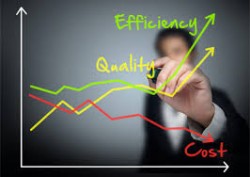Supply Chain Business Analytics Provides Better Vendor Management
 A key factor of supply chain vendor management is collaboration between partners. Sharing information and collaborating ensures that manufacturers are able to make use of supply chain partner information to help fulfill demand more quickly within order cycle times. In addition, manufacturers can become more nimble, which will result in reduced lead times because supply chains are more clearly visible. Inventory will be reduced, stockouts will be eliminated and products that are not selling can be removed. But in order to build a stronger network of vendors, manufacturers need to get a 360 degree view of how their vendors are performing, where the weak links are, and where areas of opportunity for vendor management lie. All of this and more can be done with supply chain business analytics.
A key factor of supply chain vendor management is collaboration between partners. Sharing information and collaborating ensures that manufacturers are able to make use of supply chain partner information to help fulfill demand more quickly within order cycle times. In addition, manufacturers can become more nimble, which will result in reduced lead times because supply chains are more clearly visible. Inventory will be reduced, stockouts will be eliminated and products that are not selling can be removed. But in order to build a stronger network of vendors, manufacturers need to get a 360 degree view of how their vendors are performing, where the weak links are, and where areas of opportunity for vendor management lie. All of this and more can be done with supply chain business analytics.
With supply chain business analytics companies can better monitor vendor lead times, schedules and fill rates to:
- minimize incorrect material quantities
- reduce short deliveries
- eliminate excess orders
- minimize the receipt of defective or wrong products and materials
- reduce early / late supply deliveries
Supply chain business analytics can help manufacturers identify which vendors they can count on to deliver products at the right price and on-time. For instance, if a manufacturer is buying stock from three different vendors supply chain BI software can help pinpoint which vendors are routinely late on shipping orders, the average purchase price by vendor, lead time variability, and more. If one vendor is clearly underperforming they need to be removed from your supply chain to minimize risk and save on spending. A crucial part of vendor management involves understanding which vendors are helping and which are actually hurting your supply chain. Sometimes the truth is buried dozens of disconnected reports that don’t give manufacturers the whole picture. Business intelligence analytics can connect the dots.
Proper vendor management with supply chain BI software also means tracking the performances of your supplier’s suppliers as well. While those vendors may not have a direct impact on your supply chain they can have a significant, albeit indirect, impact. For instance, let’s say a publishing company purchases their binding machines from Vendor A. Meanwhile Vendor A purchases several components of their machines from Vendor B. If Vendor B is in Taiwan and Taiwan is hit by a natural disaster then production is shut down indefinitely. That means Vendor A is missing a critical component of their supply chain and they are unable to keep up with orders from the publishing company. Now the publisher’s business and printing supply chain is affected.
With a supply chain business intelligence solution in place, the publisher would know their printing process is about to be hit, so they can proactively contact customers and let them know about the upcoming delay. According to Gartner, enterprises that provide customers and trading partners with visibility of orders, shipments and events across the extended supply chain will experience up to a 15% increase in profitability because they will be able to reduce inventory while increasing customer satisfaction.
Any enterprise that engages in multiple B2B trading relationships stands to gain even more from business intelligence analytics because the software can monitor and evaluate the entire web of vendors and partners and distributors. There don’t have to be any “dark spots” in the supply chain.
Building an extended information supply chain with business analytics has numerous benefits for manufacturers and distributors. Overall, it will reduce lead times, improve coordination of production and distribution, eliminate stock outs, minimize on-hand inventory, reduce working capital, and more. This can ultimately lead to greater profits, an increase in market share, and a stronger competitive position.